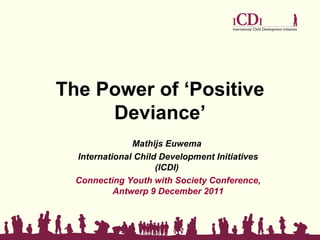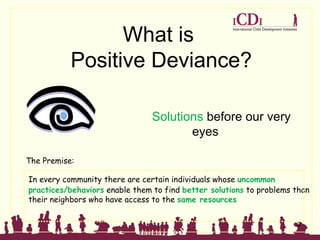Positive deviance connecting youth with society conference
- 1. The Power of ¡®Positive Deviance¡¯ Mathijs Euwema International Child Development Initiatives (ICDI) Connecting Youth with Society Conference, Antwerp 9 December 2011
- 2. What is Positive Deviance? Solutions before our very eyes The Premise: In every community there are certain individuals whose uncommon practices/behaviors enable them to find better solutions to problems than their neighbors who have access to the same resources 2
- 3. Positive Deviance (PD) Approach ? Identifying Solutions to Community Problems Within the Community Today The Key Question? What enables some members of the community (the ¡°Positive Deviants¡±) to find better solutions to pervasive problems than their neighbors who have access to the same resources? 3
- 4. PD Inquiry Establishes community behavioral norms related to the problem to be addressed Uncovers successful uncommon behaviors/ strategies practiced by the Positive Deviants 4
- 5. Analyzing PD Findings rs av i o es gi B eh te ra st s PD ice ct PDI findings are passed through pr a a conceptual ¡°accessibility sieve¡± Only those behaviors/strategies Ac Ac accessible to all are kept ce ce ss ss iib bll e e The rest are ¡°TBU,¡± True but Useless (i.e. to to Al Al not accessible to all) and are discarded ll 5
- 6. Focus on PD Behavior We can¡¯t (yet) clone people ? But we can adopt their successful behaviors/strategies 6
- 7. PD Focus on Practice rather than knowledge ¡°It¡¯s easier to ACT your way into a new way of THINKING, than to THINK your way into a new way of ACTING¡± 7
- 8. PD enables us to act complex, interlinked underlying causes . . . TODAY Although most problems have The presence of Positive Deviants demonstrates that it is possible to find successful solutions TODAY before all the underlying causes are addressed! 8
- 9. PD Inquiry is an ¡°Ends¡± as well as ¡°Means¡± MEANS To discover successful, replicable PD behaviors ENDS To empower community to discover and ¡°own¡± their own solution, based on their own resources 9
- 10. ICDI¡¯s Positive Deviance project in Netherlands 2010 Funded by Ministry of SZW as part of the European year to fight poverty and social exclusion
- 11. Our idea: mainstream non formal leisure time activities can support integration of children and youth with a migrant background. (we coined the term ¡®yomics¡¯ and ¡®yomacs¡¯; youth from minority and youth from majority cultures)
- 12. What we did -Interviews and focus groups with youth who participate or have participated in mainstream non formal leisure time activities -Similar interviews with youth workers/experts etc. -Draft a discussion paper based on these interviews and desk research -Seminar to bring stakeholders together and to generate enthusiasm for the Positive Deviance approach
- 13. Seminar
- 15. Some quotes ¡°Kinderen hebben mensen nodig die in hen geloven.¡± Lilia, teenage moeder, nu HBO student ¡°Het zou zo goed zijn indien we wat meer met elkaar konden praten, dingen konden bespreken en konden doen. Met de gemeente, met ander jongerenwerkers, met ouders, met jongeren. Samen.¡± Salim, jongeren opbouwwerker ¡°Ik heb daar geleerd hoe ik me zelf kan verwoorden en hoe ik sneller contact kan maken met anderen. Ik heb er meer zelfvertrouwen door gekregen.¡± Umut, deelnemer aan studentenmentorprogramma
- 16. Important notions -Don¡¯t focus on what goes wrong, focus on what works; -Positive deviant adults play a crucial role; -Listen to positive deviant youngsters and involve them in activities (even better: let them design, initiate and lead activities); -Stop the well meant but ineffective little ¡°sexy¡± youth participation projects; instead use the PD approach to stimulate and develop community based initiatives;
- 17. ¡°Action¡± Plan (using the Positive Deviance approach) Step 1: You, municipal policymaker, youthleader, trainer, teacher, parent, etc., you make an inventory in your street, neighbourhood or municipality, of people and organizations that organize non-formal leisure activities for childrend and young people. Stap 2: You engage in conversations with people organizing such activities. You also look closely at where already is being worked with mixed groups of Yomics and Yomacs. Stap 3: You invite the different organizations and individuals for exchange meetings. During these meetings you will try and create enthusiasm for the idea of involving more Yomics in their activities. Together you formulate strategies to make this happen. Stap 4: More Yomics are being involved in non-formal leisure time activities. You oversee this process and regularly organize follo-up meetings with the stakeholders. Succes stories are being collected and shared with the media and community.
- 18. Discussion -Can it be this simple? -What is your opinion of the usefulness of the Positive Deviance approach to stimulate integration of migrant youth (or for other youth issues)? -Other things?



















